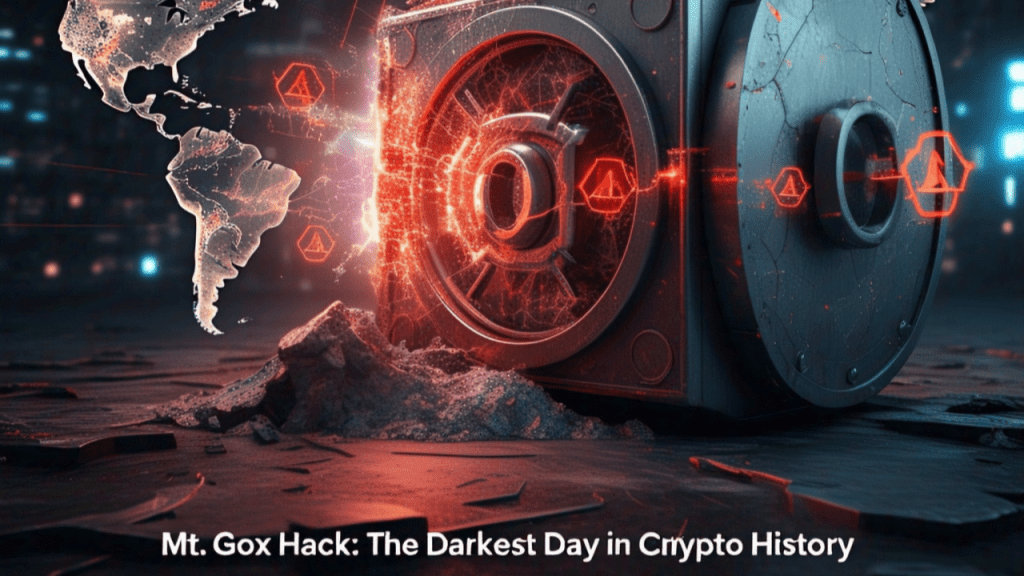
The Mt. Gox Crypto Hack: Betrayed by Trust (2014)
The Collapse of a Crypto Giant
The Fall of Mt. Gox
In February 2014, the world witnessed one of the most devastating cryptocurrency exchange hacks in history—the Mt. Gox crypto hack. This incident saw the theft of approximately $473 million worth of Bitcoin, shaking the crypto community to its core. As one of the earliest and most significant breaches, the Mt. Gox crypto hack raised urgent questions about security and regulation in the crypto space.

1. The Rise and Dominance of Mt. Gox
Mt. Gox wasn’t always a crypto exchange. It started as a platform for trading Magic: The Gathering cards before diving into the world of Bitcoin. By 2013, it was handling over 70% of all Bitcoin transactions globally. Its rapid rise was fuelled by being one of the first and most accessible exchanges, offering low fees and a user-friendly interface. However, the speed of its growth outpaced its ability to secure its systems, setting the stage for disaster.
2. How the Hack Happened
Mt. Gox’s security had cracks right from the start. The exchange relied on outdated software, lacked multi-signature wallets, and had poor auditing practices. The attackers exploited a flaw known as the Transaction Malleability Bug, which allowed them to alter transaction IDs. Over the years, they siphoned off Bitcoin in small amounts, accumulating to a staggering 850,000 BTC by 2014. Shockingly, the breach had been ongoing since 2011 without detection.

3. Who Was Responsible?
The question of who was behind the attack remains partly a mystery. Some experts suspect Russian hacker groups due to similarities with other Eastern European cyber-attacks. Others point to insider involvement, with allegations against CEO Mark Karpelès ranging from negligence to direct complicity. Independent blockchain analysis by firms like WizSec traced some of the stolen funds but never fully cracked the case.

4. The Aftermath: Bankruptcy and Legal Battles
By March 2014, Mt. Gox filed for bankruptcy in Japan, admitting the loss of 850,000 BTC. Mark Karpelès was later arrested and faced charges of embezzlement and data manipulation. While he was acquitted of embezzlement, he was found guilty of falsifying records. In 2021, a compensation plan was approved, allowing creditors to reclaim part of the recovered 200,000 BTC.
5. The Impact on Bitcoin and Crypto Regulations
Bitcoin’s price took a nosedive, dropping over 36% as panic spread. The hack highlighted the urgent need for stronger security and regulatory frameworks. Japan responded with the Payment Services Act in 2017, setting up a licensing regime for exchanges. This incident also led to the widespread adoption of security practices like multi-signature wallets and proof of reserves.
6. Lessons Learned from the Mt. Gox Crypto Hack
The Mt. Gox crypto hack was a harsh lesson in crypto security. It underscored the importance of cold storage, mandatory security audits, and transparency from exchanges. For users, the takeaway was clear: don’t store large amounts of crypto on exchanges.
Conclusion: A Turning Point for Crypto Security
The Mt. Gox crypto hack was a wake-up call for the entire crypto industry. Its fallout reshaped security practices, regulations, and user awareness. As the crypto world evolves, the lessons learned from this catastrophic event continue to influence exchange security standards today.

Secure Your Crypto with a Cold Wallet
Keeping your crypto safe is more important than ever. With the rise of ETF staking and institutional adoption, protecting your Bitcoin and other digital assets should be a top priority.
A cold wallet ensures that your funds remain safe from hacks, scams, and online threats. Unlike hot wallets, which are connected to the internet, cold wallets keep your private keys offline, offering maximum security.
🔒 Top Cold Wallets to Consider:
👉 Ledger Stax – A next-gen E Ink touchscreen wallet designed for seamless crypto security.
👉 Trezor Safe 5 – A highly secure hardware wallet with advanced protection features.
Don’t leave your crypto at risk. Invest in a cold wallet today and take control of your digital assets! 🚀
Quiz: Answer the following questions in 2-3 sentences each.
- What was Mt. Gox originally created for before becoming a Bitcoin exchange?
- How much Bitcoin was stolen in the Mt. Gox hack?
- What security flaw did hackers exploit to carry out the attack?
- Why was the Mt. Gox hack significant for crypto regulations globally?
- What were some theories about who was responsible for the hack?
- How did the hack impact Bitcoin’s price?
- What steps did Mt. Gox take after discovering the hack?
- What were the main lessons learned from the Mt. Gox hack?
- Why is cold storage important for crypto security?
- What role did the Mt. Gox hack play in shaping exchange security standards?
Quiz Answer Key:
- Mt. Gox was originally a platform for trading Magic: The Gathering cards.
- Approximately $473 million worth of Bitcoin was stolen.
- Hackers exploited a transaction malleability bug to alter transaction IDs.
- The hack led to stricter regulations and security standards globally.
- Theories included Russian hacker groups and potential insider involvement.
- Bitcoin’s price dropped by over 36% following the hack.
- Mt. Gox filed for bankruptcy and attempted to compensate affected users.
- Key lessons included the importance of cold storage and regular audits.
- Cold storage keeps private keys offline, protecting them from online threats.
- It led to enhanced security protocols, including proof of reserves and audits.








